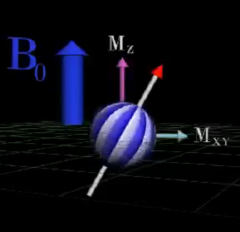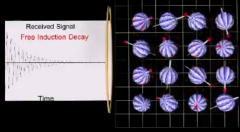![]()
![]()
![]()
Use LEFT and RIGHT arrow keys to navigate between flashcards;
Use UP and DOWN arrow keys to flip the card;
H to show hint;
A reads text to speech;
16 Cards in this Set
- Front
- Back
|
What are the units of magnetic force?
|
Tesla = 10,000 gauss
Earth's magnetic force = 0.5 Gauss = to 50 microTeslas Average MRI is 0.5-3 Teslas (10,000-60,000 earth's magnetic field) |
|
|
In MRI we focus on the dipole moment of which element?
|
Hydrogen
The dipole has a direction and magnitude and a spin. Atoms with even atomic number and even atomic mass will have no magnetism (the subatomic dipoles will pair and diminish their effective magnetism) ie. Carbon and Calcium |
|
|
Describe precession and the larmor freqency
What is the larmor freqency for protons in a 1 Tesla magnet? |
When a spinning hydrogen atom experiences a magnetic field it will orient itself along the field and rotate (precession) in an angular pattern around the applied field at an angular frequency, w.
w = gamma Bo w=angular freqency (rad/sec) gamma= gyromagnetic ratio (unique to each element) Bo= applied magnetic field strength Larmor frequency of protons in 1 Tesla magnet 42.58 |
|
|
When an external magnetic field is applied, what are the 2 orientations of the dipole? Which has the lower energy and is more stable?
|
parallel and antiparallel
parallel |
|
|
As the proton precesses, the vector representing the magnetic moment is tilted away from the applied magnetic field (z axis). The vector can then be defined how?
|

Mz = parallel to the field
Mxy = perpendicular to the field and rotates |
|
|
how many hydrogen protons are present in 1mm^3 voxel?
|
10^19
|
|
|
Describe longitudinal relaxation (T1 Relaxation)
|
When a magnetic field is first applied (time=0) there will be equal number of parallel and antiparallel hydrogen dipoles resulting in an Mz vector with net 0 magnitization. With time, the antiparallel dipoles will "flip" and orient themselves in the parallel direction resulting in gradually increasing magnetization. The time it takes the longitudinal magnetization vector to grow to 63% of its maximum value is defined as T1 Relaxation time
|
|
|
What is transverse Magnetization (T2 Relaxation)
|
When a magnetic field is first applied (time =0) the protons randomly and asynchronously precess resulting in a Mxy vector with net 0 magnetization.
When an RF pulse of 42.58 MHz (same as proton larmor frequency) is applied, the Mxy vectors will align and precess synchronously. They will gradually de-synchronize resulting in decay of signal (The rate of which is unique to tissue) |
|
|
What does the 90 RF pulse do to the Mz and Mxy vectors?
|
It results in a net Mz vector of 0 by equalizing the parallel and anti-parallel protons.
It results in the maximum net Mxy vector magnitude because the protons precess synchronously |
|
|
What does the 180 Rf pulse do?
|
It flips all of the proton dipoles to the high energy antiparallel configuration
|
|
|
How do we measure the Mxy vector magnitude?
|

The synchronous precession in the Mxy plane will induce an alternating current in the RF coil at the same frequency and amplitude of precession. (Faraday's law).
|
|
|
What is the Term given to the time it takes for the Mz vector to reach 63% of its maximal value?
How long does it take to reach >99% maximum value? |
T1 relaxation period
5T1 relaxation periods |
|
|
What are the relative relaxation and echo times to get the following image contrast
Proton Density T1 Contrast T2 Contrast |

Proton Density: Long TR, Short TE
T1 Contrast: Short TR, Short TE T2 Contrast: Long TR, Long TE |
|
|
What is the term given to the time it takes for the Mxy vector to lose 63% of it maximal value?
|
T2 relation period
|
|
|
(T1/T2) is dependent upon field strength?
|
T1 is proportionally dependent on field strength
|
|
|
What is T2* decay
|
T2 assumes perfect field homogeneity that results in uniform dephasing of signal. However, the magnetic field isn't perfect for 2 reasons (a gradient is applied for spatial encoding and 2 the magnetic field isn't perfectly uniform) This results in acclerated de-phasing termed T2* decay.
|

